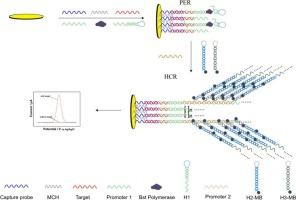Electrochemical biosensor constructed using dual-signal amplification techniques (PER-HCR) for the ultrasensitive trace detection of ctDNA BRAF mutation
IF 4.5
2区 化学
Q1 BIOCHEMISTRY & MOLECULAR BIOLOGY
引用次数: 0
Abstract
The detection of BRAF mutations in circulating tumor DNA is beneficial for early diagnosis and personalized therapeutic approaches of melanoma. However, the sensitive and reliable trace detection of BRAF mutations remains a major challenge. Therefore, in this study, the combination of two isothermal signal amplification techniques (primer exchange reaction (PER) and hybridization chain reaction (HCR)) was proposed to construct an electrochemical biosensor for the efficient and sensitive detection of BRAF mutations. The presence of target triggered PER and HCR sequentially to achieve dual-cascade amplification of positive electrochemical signal feedback. Compared to the detection limit (1.27 pM or 0.23 pM) of single-signal amplification technology (PER or HCR), the detection limit of dual-signal amplification techniques was significantly lower (0.34 fM). In addition, the dual-signal amplification strategy exhibited other excellent sensing properties, such as a wide linear detection range (0.01 pM to 1 nM), excellent specificity, satisfactory reproducibility and stability, and the ability to achieve low-level target detection in diluted serum samples. Based on all of these features, the proposed strategy indicate broad application prospects for detecting low-abundance nucleic acid targets in clinical samples.

基于双信号放大技术(PER-HCR)构建的电化学生物传感器用于ctDNA BRAF突变的超灵敏痕量检测。
循环肿瘤DNA中BRAF突变的检测有助于黑色素瘤的早期诊断和个性化治疗。然而,对BRAF突变进行敏感可靠的微量检测仍然是一个重大挑战。因此,本研究提出结合两种等温信号扩增技术(引物交换反应(PER)和杂交链反应(HCR)),构建一种高效灵敏检测BRAF突变的电化学生物传感器。目标的存在依次触发PER和HCR,实现电化学正信号反馈的双级联放大。与单信号放大技术(PER或HCR)的检出限(1.27 pM或0.23 pM)相比,双信号放大技术的检出限(0.34 fM)显著降低。此外,双信号放大策略还具有其他优良的传感特性,如宽的线性检测范围(0.01 pM至1 nM)、优异的特异性、令人满意的重现性和稳定性,以及在稀释的血清样品中实现低水平目标检测的能力。基于以上特点,该方法在临床样品中检测低丰度核酸靶点具有广阔的应用前景。
本文章由计算机程序翻译,如有差异,请以英文原文为准。
求助全文
约1分钟内获得全文
求助全文
来源期刊

Bioelectrochemistry
生物-电化学
CiteScore
9.10
自引率
6.00%
发文量
238
审稿时长
38 days
期刊介绍:
An International Journal Devoted to Electrochemical Aspects of Biology and Biological Aspects of Electrochemistry
Bioelectrochemistry is an international journal devoted to electrochemical principles in biology and biological aspects of electrochemistry. It publishes experimental and theoretical papers dealing with the electrochemical aspects of:
• Electrified interfaces (electric double layers, adsorption, electron transfer, protein electrochemistry, basic principles of biosensors, biosensor interfaces and bio-nanosensor design and construction.
• Electric and magnetic field effects (field-dependent processes, field interactions with molecules, intramolecular field effects, sensory systems for electric and magnetic fields, molecular and cellular mechanisms)
• Bioenergetics and signal transduction (energy conversion, photosynthetic and visual membranes)
• Biomembranes and model membranes (thermodynamics and mechanics, membrane transport, electroporation, fusion and insertion)
• Electrochemical applications in medicine and biotechnology (drug delivery and gene transfer to cells and tissues, iontophoresis, skin electroporation, injury and repair).
• Organization and use of arrays in-vitro and in-vivo, including as part of feedback control.
• Electrochemical interrogation of biofilms as generated by microorganisms and tissue reaction associated with medical implants.
 求助内容:
求助内容: 应助结果提醒方式:
应助结果提醒方式:


